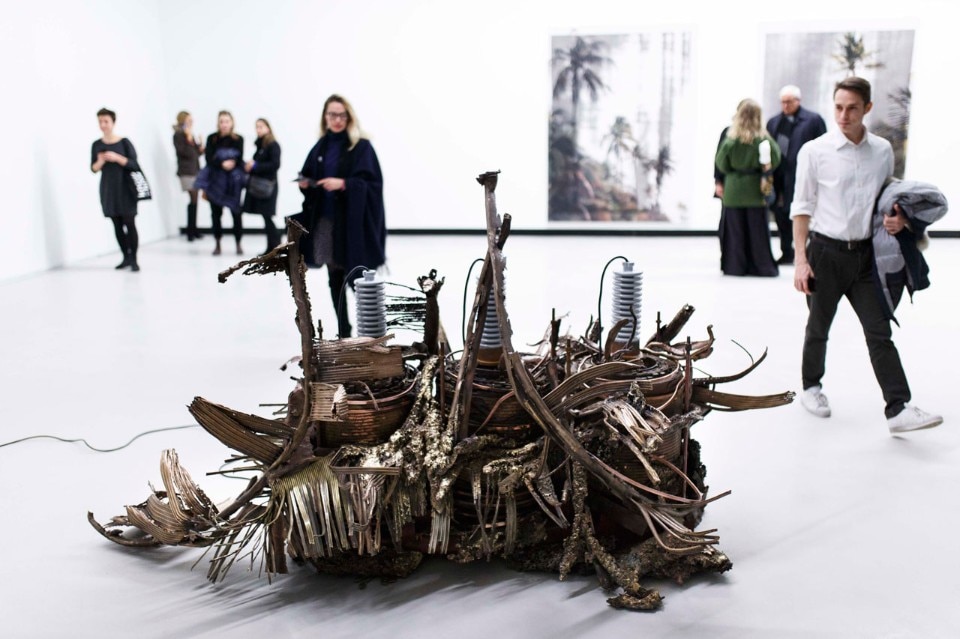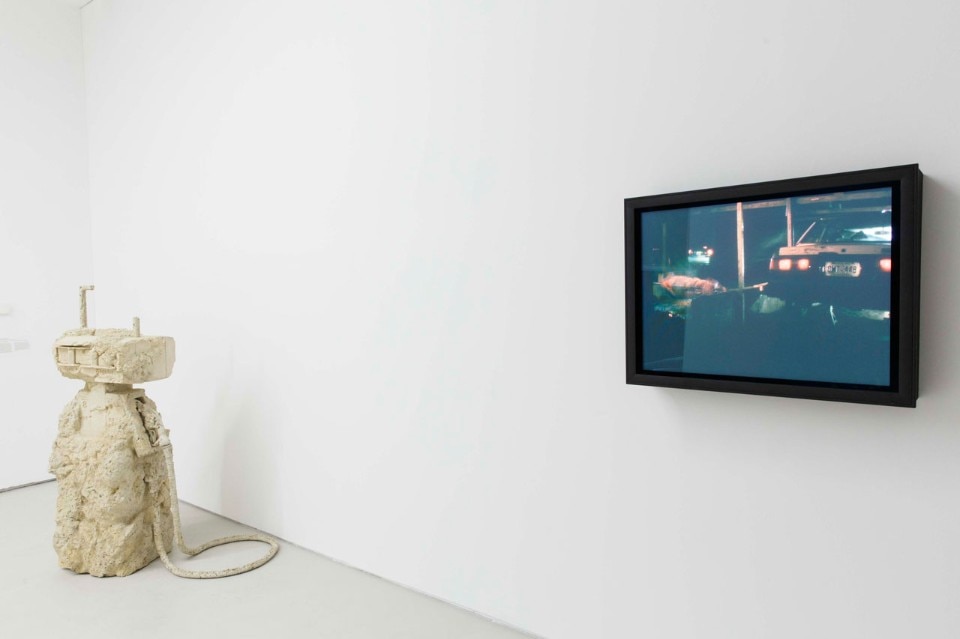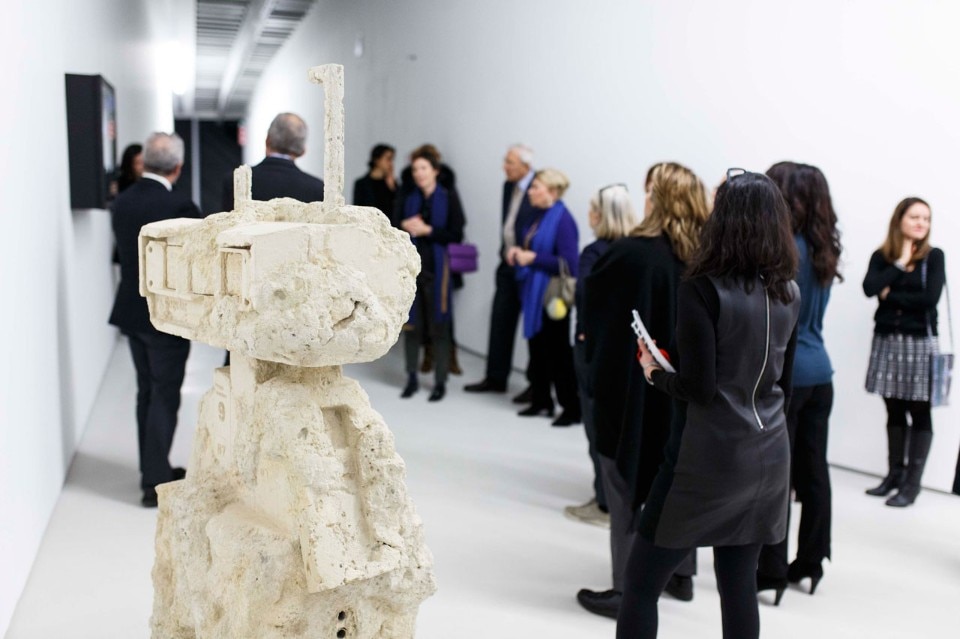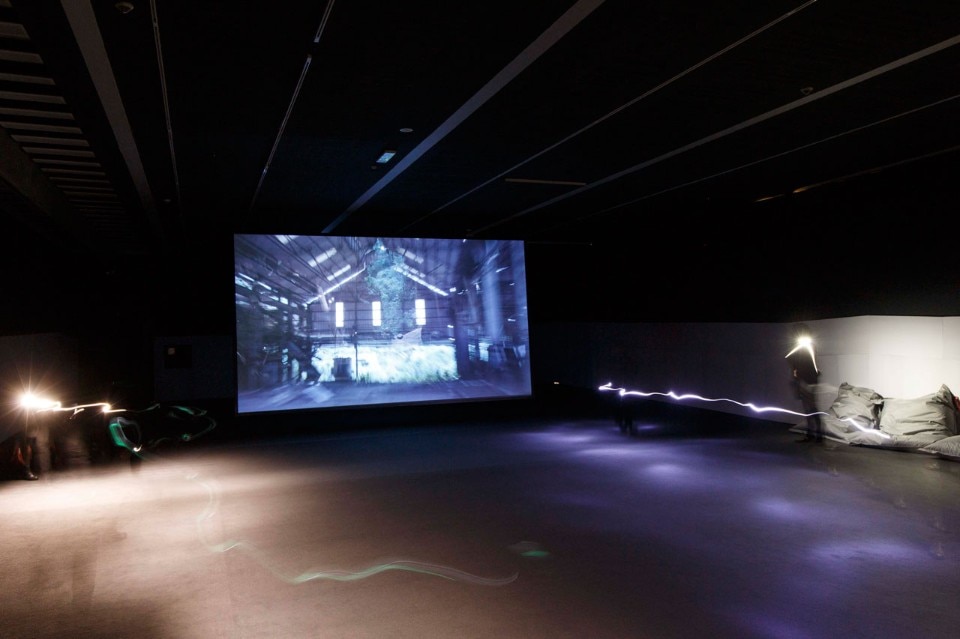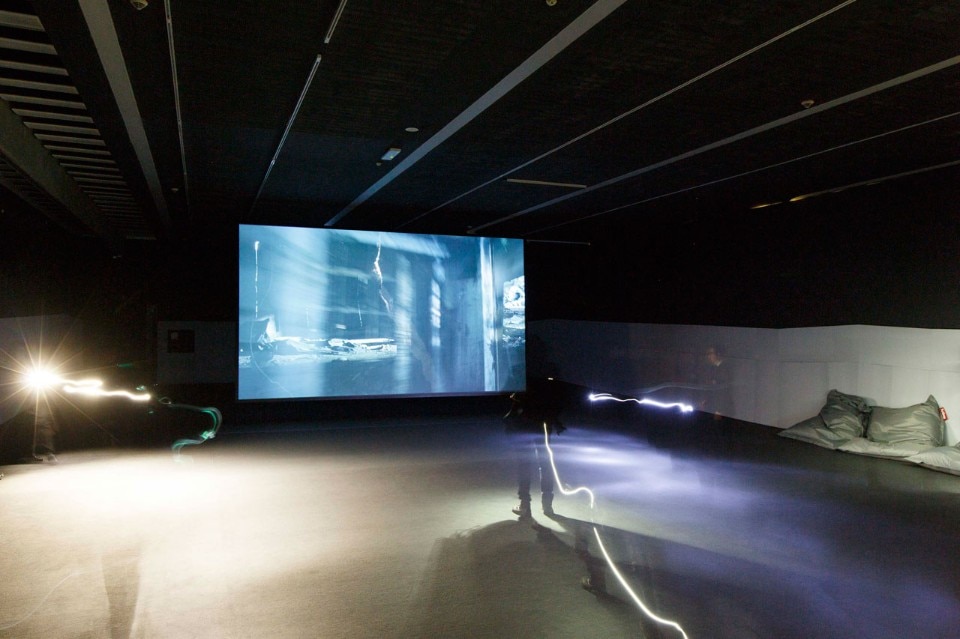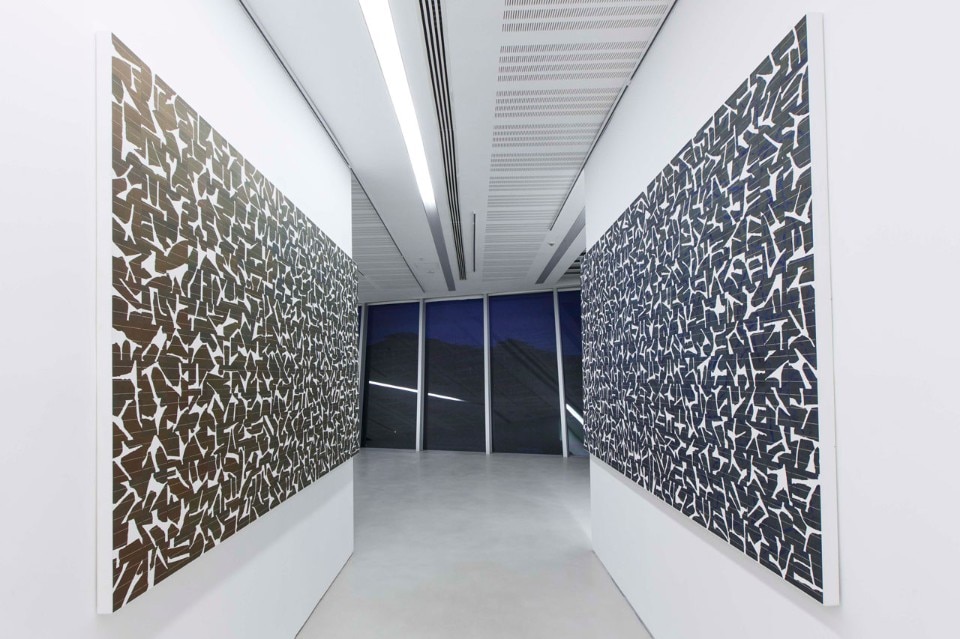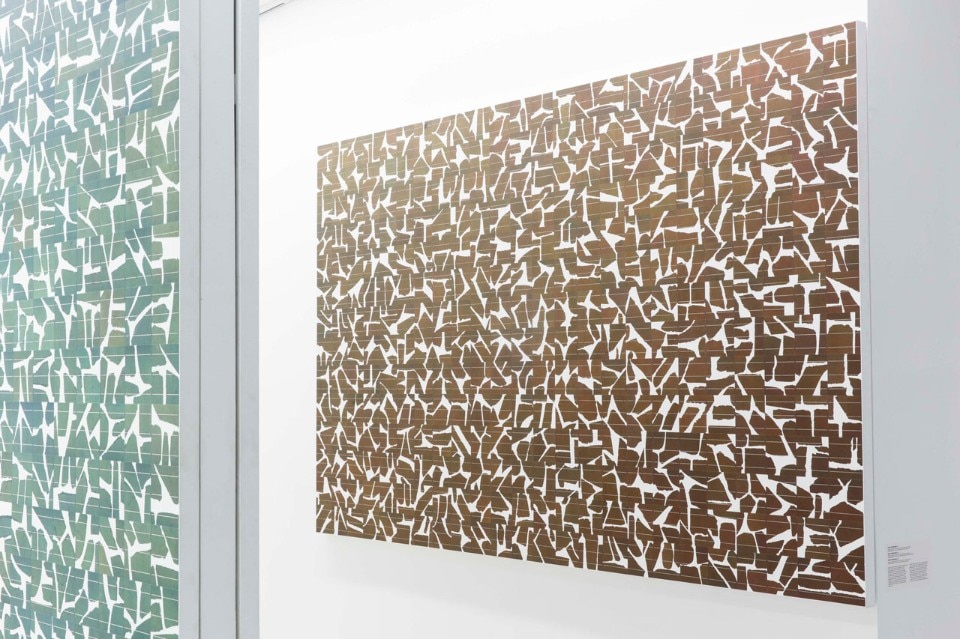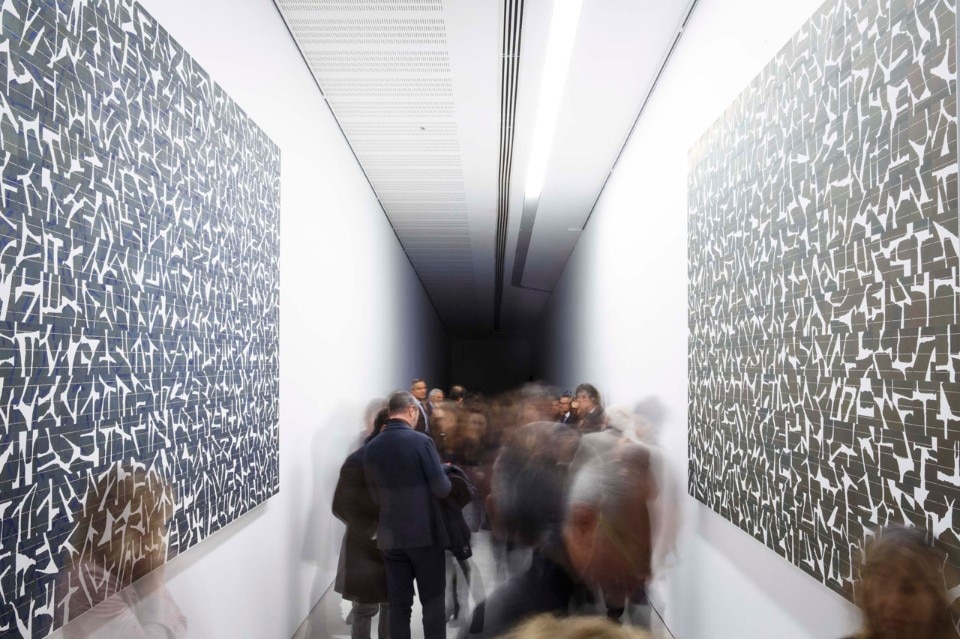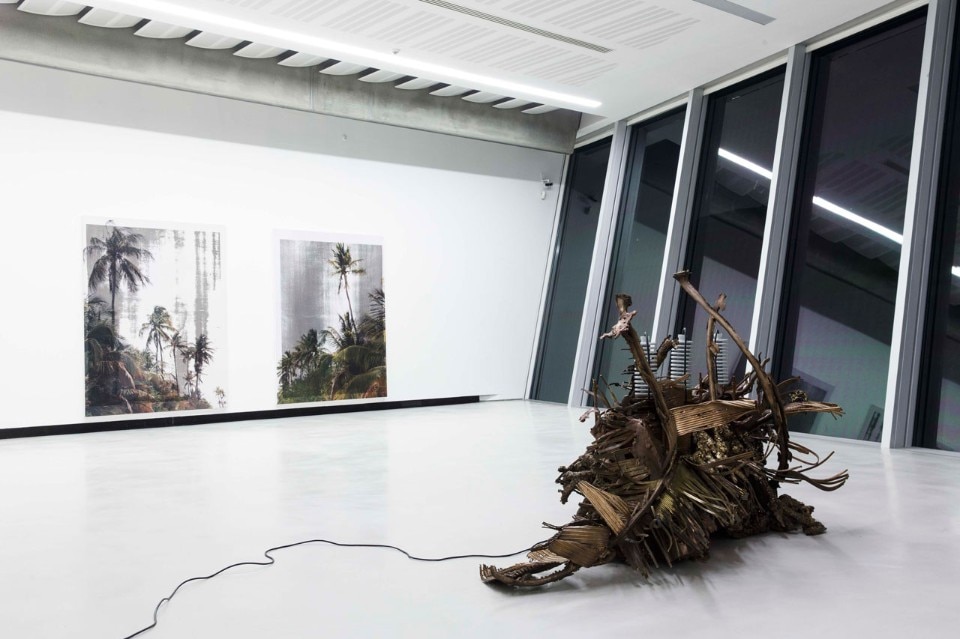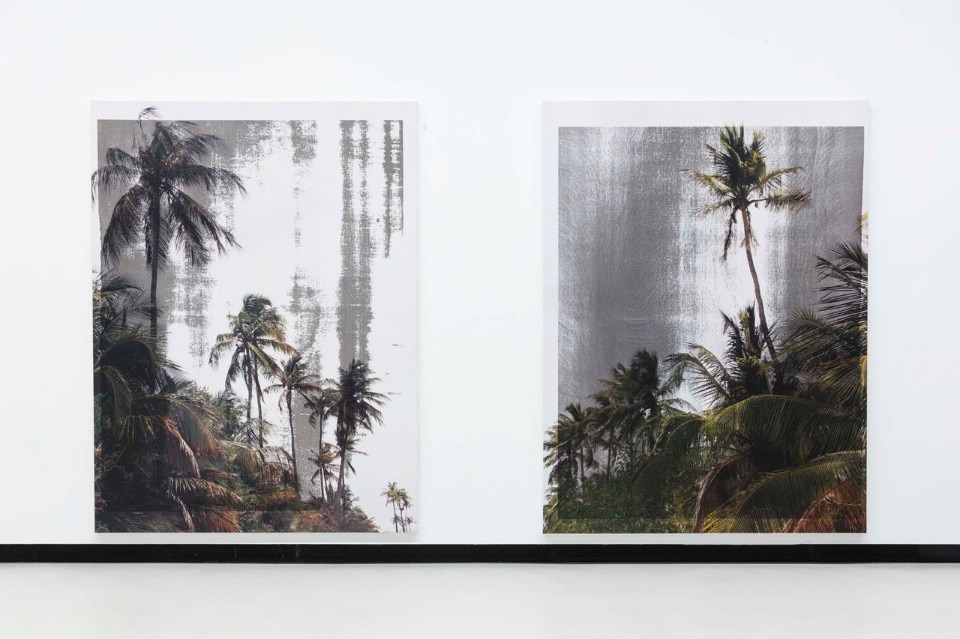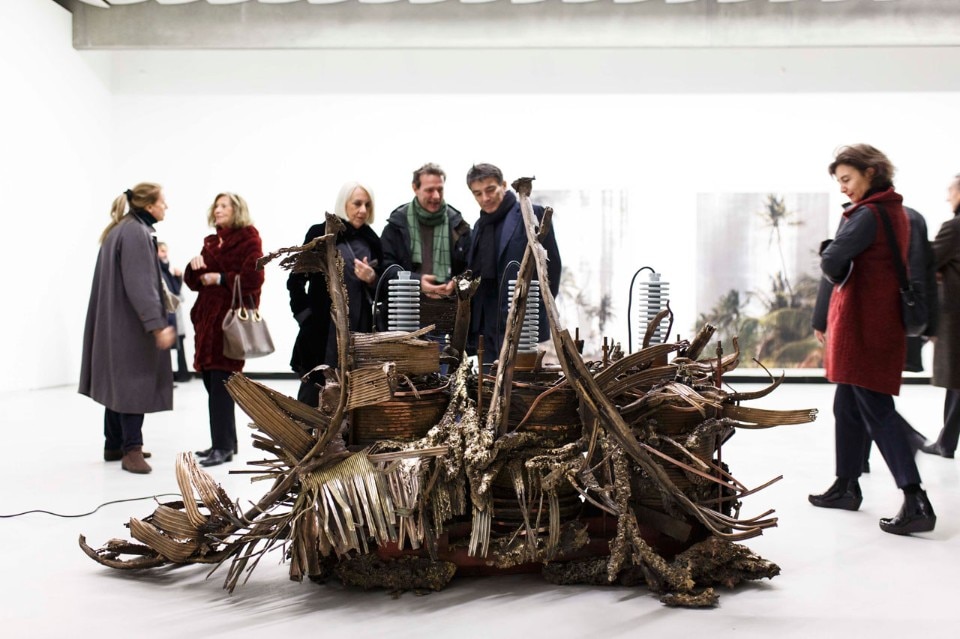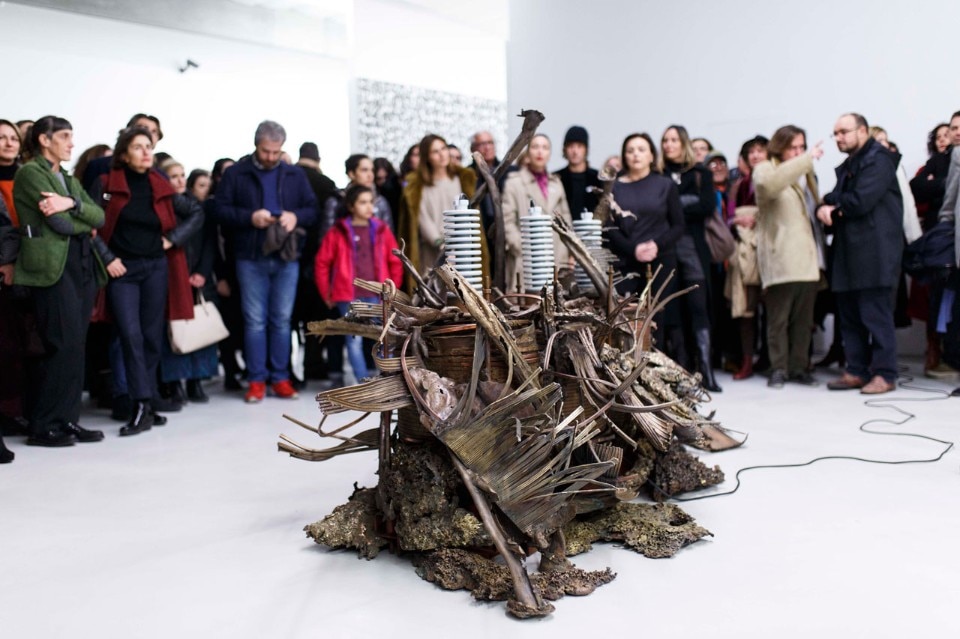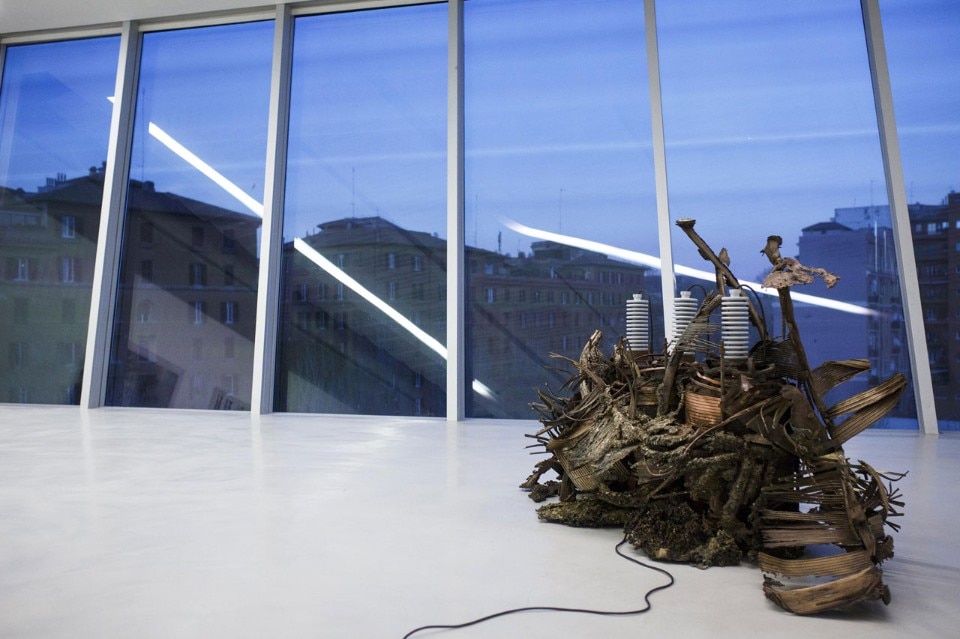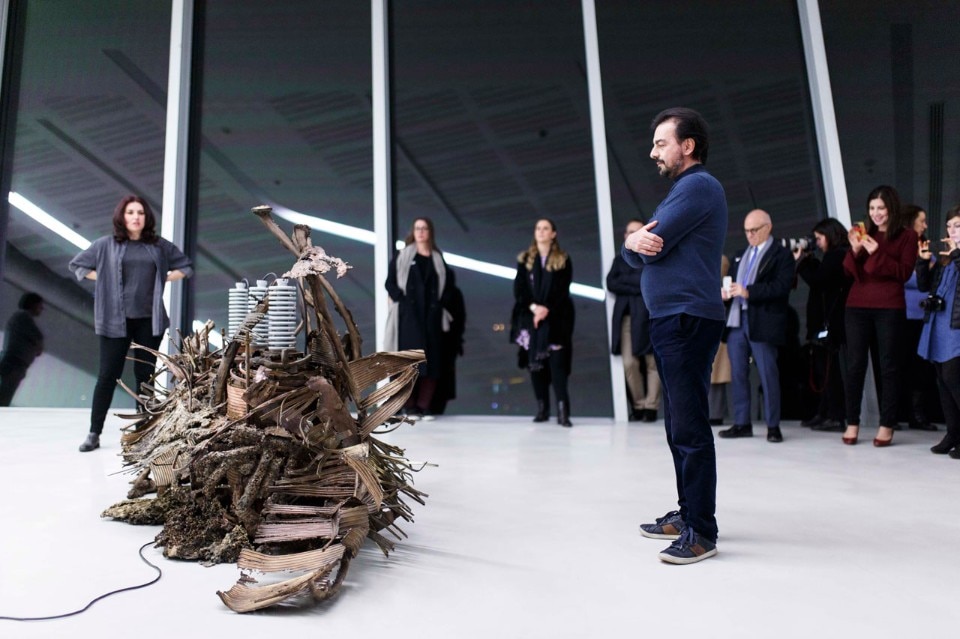The large and brightly-lit Gallery 5 at the MAXXI has been completely re-designed by the arrival of Jennifer Allora and Guillermo Calzadilla. The Puerto Rican artists have transformed the space into an unstable and uncertain environment. The addition of a long wall behind the entrance has created a small atrium; the entrance now has the appearance of a crooked frame, an off-axis framing which leads to a precarious and unsettling world. In the corner, up against the new wall, an abandoned petrol pump lays solemnly. It has been transformed into a washed-out and funereal block of limestone, petrified over time. The evocative symbol of industrialisation, consumerism and exploitation haggardly gazes at us. It has been reduced to a relic of the future, the carcass of a robot with a resigned air. The scenario that we will leave to our heirs on earth is, according to the duo, a place where today’s technology has been turned into fossils, paradoxical archaeological refuse.
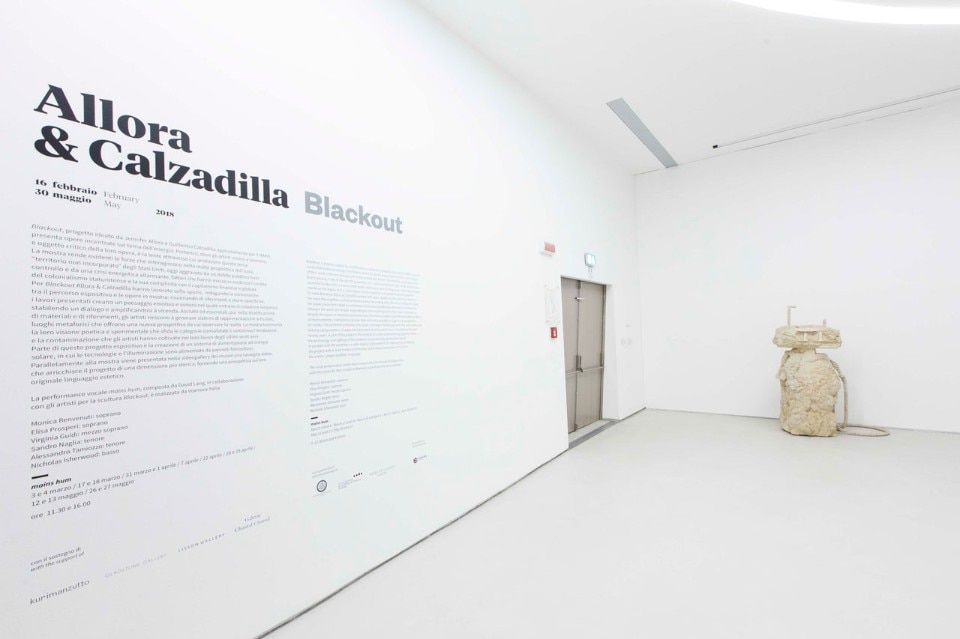
This unsettling vision is the premise of “Blackout”, the exhibition that the artists have brought to Roma, once again choosing to speak about Puerto Rican history. The island where the couple live has for years been the subject of their research as a social-political case and a privileged point of view for the paraphrasing of important global dynamics. The land which was once known as the shining star of the Caribbean is now unincorporated United States territory. Consequently, although it is a part of the USA, it does not have its own sovereignty, and is to all intents and purposes a modern colony. Exploited, struck by the economic crisis and public debt which is out of control, for 60 years the island has been a place of speculation and military exercises carried out by the Americans, who subjected the local inhabitants to extensive dispossession.
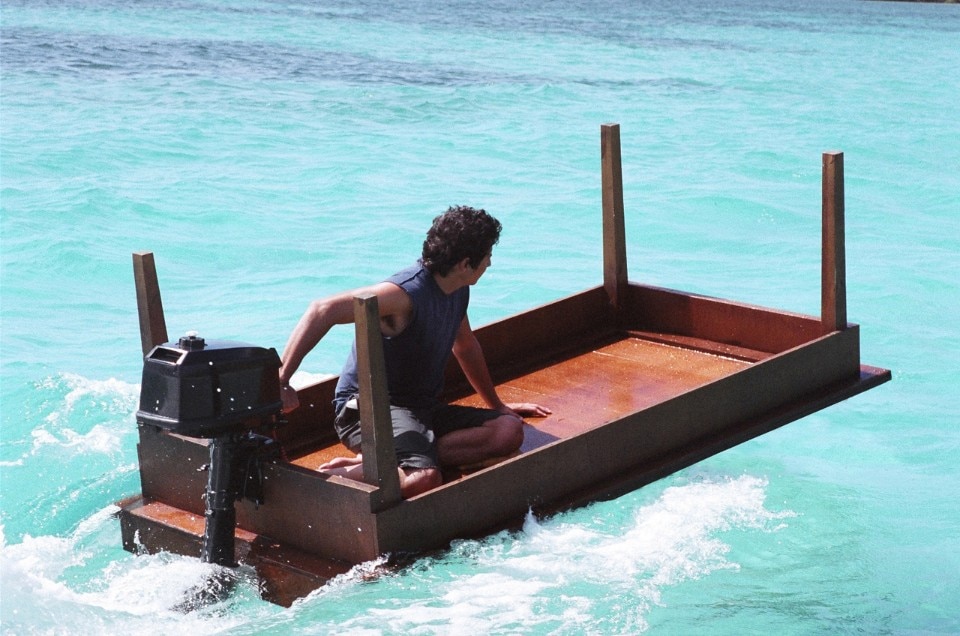
In the famous 2005 video Under Discussion, a young dissident travels on an overturned table, transforming it into a motorboat. Crossing the sea, he reaches the beautiful coasts that the Puerto Ricans are unable to access due to military exercises. Metaphorically, the man takes a conference table to the places which have been taken away from the local inhabitants. “The work - says Guillermo Calzadilla - makes reference to various themes including ecology, which in this case does not refer to plants or animals, but to human beings. Through dispossession, the local population had been confined to the centre of the island of Vieques (which is part of Puerto Rico), deprived of access to agriculture and fishing, activities which are fundamental for subsistence; it had therefore become a species under risk of extinction”.
Again, in Returning a Sound, the protagonist is a dissident; travelling the forbidden areas on a moped with a trumpet that he has fixed to the exhaust pipe. The work introduces one of the themes which has been a constant in the duo’s work for some time, sound. The continuous lament which sounds during the long journey across the island brings to mind a large number of associations. “The trumpet is an instrument which was created for war, to provide motivation during battles, to sound the fall-in, to commemorate and to create a collective identity. Music was traditionally used as a weapon, and even as a form of torture in the Guantánamo detention camp. The desire to work on sound emerged after having heard bombs explode in Vieques, a literally terrifying experience. We began to question the political role of sound and its history, and we linked it to militarism. Now we are studying its relation to electricity”.
It was this final phase of research that led, in 2017, to the creation of Blackout, the work which lent its name to the entire exposition. At the centre of the hall, a large electromagnetic transformer is stranded like an enormous relic. The machinery exploded during a short-circuit which left the population of Puerto Rico without light and electricity. “We were interested in the physical quality of the object, in the fact that it was a relic, a survivor. The machine produces a steady sound, a buzz which, during the performance, is joined by other sounds made by singers who suddenly enter the scene. We worked with the composer David Lang and the VoxNova ensemble on the voice as a form of energy, seeking to recreate the convulsive sounds produced by a transformer before it collapses. The voice is therefore no longer words, but phonetic accumulation”.
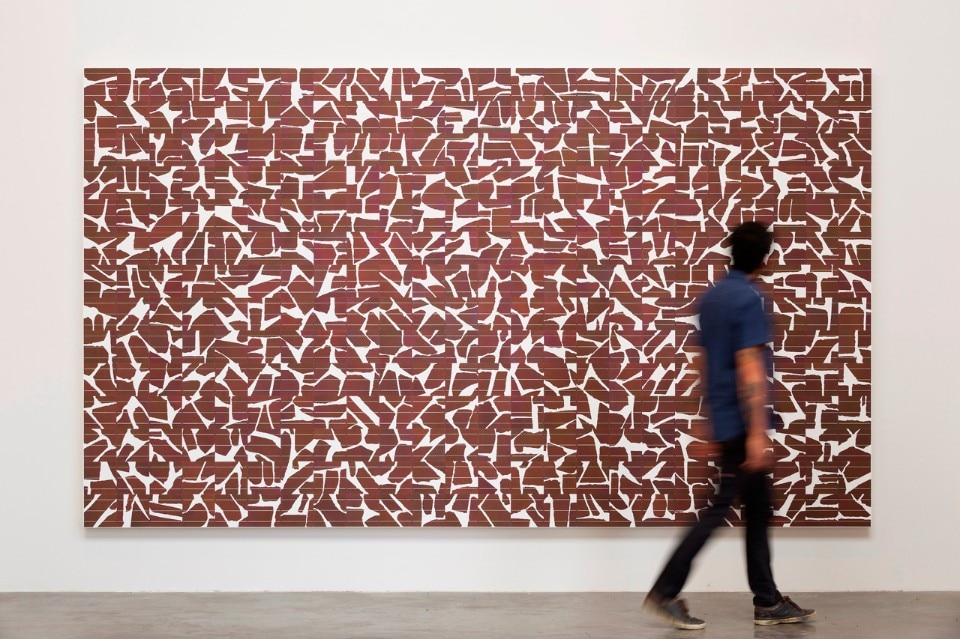
A fundamental aspect of Allora and Calzadilla’s work is stratification; their research is based on a profound and continuous bringing together of diverse subjects and matters: geopolitics, music, literature, science, ecology... Everything is connected. “I think it is impossible to find a precise theme or a specific subject in our work. We overlay multiple layers in a single work, and it is their point of convergence which interests us, the connection and dialogue between differing fields. This is also because there are two of us, and so collaboration and interdisciplinarity are structural parts of our viewpoint”. The use of performative sculpture is an example of working on various levels, fusing together static and dynamic aspects in a single work. In this process, the way in which the couple reads and uses space, leading to its transformation, concentrating on the involvement and experience of visitors, is fundamental. Their works are characterised by an extremely high level of abstraction and depth, yet are also decisively material; both conceptual and physical at the same time.
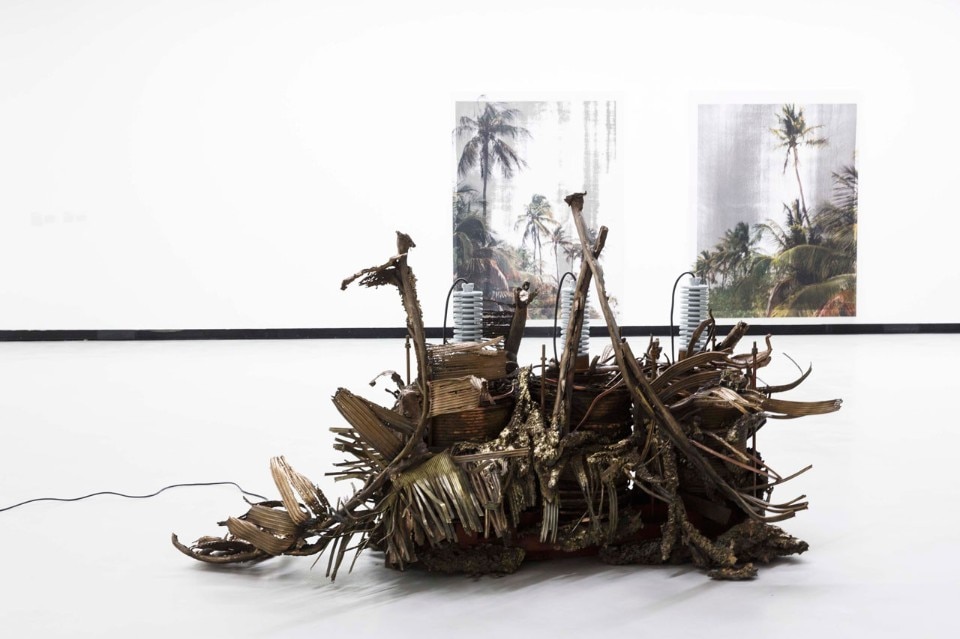
Blackout is a great work which focuses attention on the critical situation of Puerto Rico. The tragic events which have struck it, including the deadly hurricanes of 2017, have been used by the artists as a spotlight to bring attention to a situation which is little-known internationally, but which actually concerns us all. From a void, a clean slate, emerges not only destruction, but the possibility to create. Changing perspective, identifying moments which can provoke different perceptions and connections, has always been an important cornerstone of the work of Allora and Calzadilla.
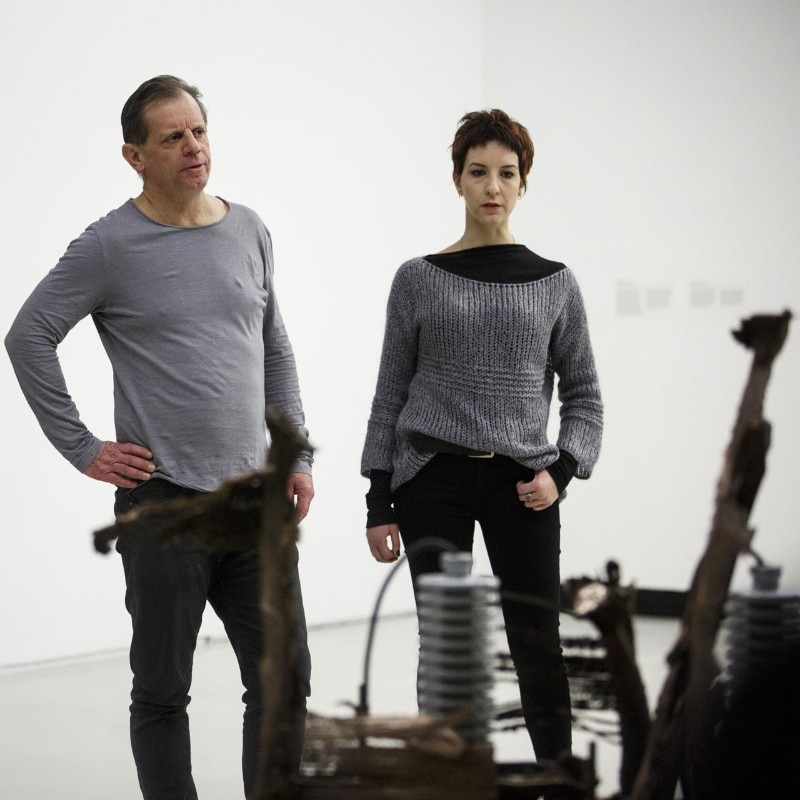
In the video The Night We Became People Again, inspiration comes from a story by the Puerto Rican writer José Luis González, who tells of an enormous blackout which struck America in 1965. In the story, a number of Puerto Rican immigrants find themselves on a roof during the night, talking, and thanks to the darkness, they are able to see the stars. Thus, a catastrophe can lead to revelations and, in this case, is also an opportunity to reunite a community. Unfortunately, the story does not have a happy ending, as at a certain point the light comes back on and everything goes back to the way it was. But that respite, that moment of reflection, generated a new point from where to move on.
- Exhibition title:
- Blackout. Allora & Calzadilla
- Curators:
- Hou Hanru, Anne Palopoli
- Opening dates:
- 16 February – 30 May 2018
- Venue:
- MAXXI
- Address:
- via Guido Reni 4A, Rome


